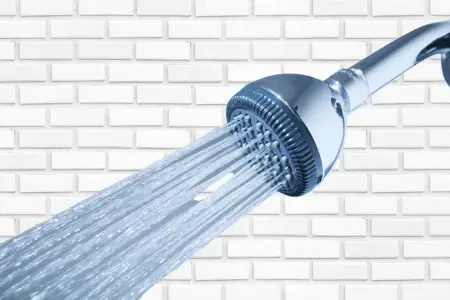Do not shower for at least 24 hours after shocking your well. Waiting for one or two days more, if possible, is much better. Chlorine levels in the well water will go down only after freshwater dilutes and replaces chlorinated water. This process can take 1-2 days.
Once you are done shocking your well, start opening up water fixtures one at a time. Keep them open until the chlorine smell is no longer coming from the water. This is necessary to ensure there are no traces of chlorine remaining in your well water.
However, don’t just rely on your gut feeling. Use chlorine test strips to verify that the water coming from the faucets, especially the yard hydrant or the garden faucet, is clear of chlorine. Read on to know how to use chlorine test strips.
What is Shock Chlorination?
Shock chlorination is done to disinfect home water systems such as wells, cisterns, and springs. It is one of the most effective ways to rid your home water system of bacterial contamination like coliform.
Chlorine or household liquid bleach are mainly used for shock chlorination.
When Should You Shock Chlorinate Your Well?
Shock chlorination should be done:
- Upon construction of a new well or when you’ve returned an old well to service
- If your well water’s test results indicate it contains bacteria
- Whenever you open your well system for installation, maintenance or repair
- If rainwater leaves your well water cloudy or muddy
- When floodwaters surround the well casing
- If the well water is giving an odor
How To Shock Your Well
Before you shock your well, there are a few precautions you need to take.
Your well water will be unusable for 12 to 24 hours after shock chlorination. So it’s imperative that you store extra water for washing in containers and buy bottled water for cooking and drinking.
Aside from that, if you have got a water treatment system, set it at “bypass”. This will make sure that the chlorinated water doesn’t end up entering the system. Once you’ve taken these precautions, follow these steps to shock your well:
Step 1: Gather the supplies
Here’s what you’d need:
- Household liquid bleach – you’d need 1 quart (1 litre) of bleach to shock every 5 feet (1.5 metres) of the depth of water
- Rubber gloves
- Goggles
- One funnel
- Old clothes
Step 2: Connect the outside spigot with a clean hose
Let the water run. If you see that it’s cloudy or muddy or contains any particles, let the water run for as long as it’s clear and free from particles. It’s necessary for the success of the whole shock chlorination process that the well water is clean.
Step 3: Turn off the well pump
Take off the pump’s switch from the plug. Do this before removing the well cover or cap to save yourself from an electric shock.
Step 4: Prepare the bleach-water solution
Wear old clothes, rubber gloves and goggles. Pour 1 gallon of bleach for every 10 gallons of water. Shake the bucket to mix the bleach into the water.
Step 5: Pour the beach-water solution into the well
How you’ll do this will depend on the type of well. If you have a dug well, simply lift its cover and pour the mixture into the well. However, if you have a different type of well, preferably one with a sanitary seal, you’d have to remove the plug or air vent and use the funnel to pour the solution.
Step 6: Turn on the well pump
Turn the electricity to the pump on and run water into the well casing from the hose. Keep on running the water until there’s a smell of chlorine coming off the hose. Then turn the hose off.
Step 7: Open up all your home’s faucets
Keep the faucets open until each one is giving a smell of chlorine. Then turn them off and flush each toilet in your home.
Step 8: Turn off the well pump
Turn off the electricity to the pump. If you had removed your well’s cover in step number five, it’s time to replace the cover. Now you must wait for 12 to 24 hours. Don’t use any flush toilets or run any water during this 1 to 2 day period. Use your freshwater reserves during this time.
Step 9: Open the outside hose
Keep on running the water until there is no chlorine smell. Make sure the chlorinated water is running into an area where it won’t contaminate septic tanks, plants, streams, or lakes. When the chlorine smell is gone, close the outside hose.
Final Step: Open the inside faucets
Keep on running water from the inside hoses until there isn’t any chlorine smell. Once the odor is gone, collect the running water in a bottle, and use chlorine test strips (explained below). If the strips indicate the water has no chlorine, it means you can safely drink it.
How To Use Chlorine Test Strips
Remove one of the chlorine test strips from the vial. Collect a bowl of water and dip the test strip into the bowl. Let the strip sit there for some time. Take out the strip and juxtapose it against the color label given on the vial’s chart.
- Enjoy Your Pool & Spa: Keep your water clean, healthy, and enjoyable with...
- Quick & Easy: Our pool testing kit takes the guesswork out of your pool and...
- Accurate & Reliable: It's never been this easy to take a faultless reading...
- 100 Test Strips: Get more for your money with our pH test strips for pool...
- Exclusive EBook: Our pool water tester kit includes an eBook packed with...
The strip’s color indicates the presence of chlorine in water in parts per million (ppm). If the strip’s color is too light, it means chlorine has evaporated from water. If its color is too dark, that means there is still plenty of chlorine in your water supply.
Frequently Asked Questions
When can you drink water after shocking well?
After shock chlorination, wait for one or two weeks before you start drinking well water. Have the water tested for E.coli bacteria and total coliform. If the test results indicate the absence of both these bacteria, you can safely restart drinking your well water.
Read this article to find out if drinking shower water is healthy.
How often should you shock a well?
Most homeowners recommend shocking private wells every 3 to 5 years. However, if you have test results on well water indicating that it contains bacteria, you may have to chlorinate the well sooner.
Why is my water yellow after shocking well?
It’s yellow because your well contains iron. Chlorine used for shocking the well will oxidize the ferrous iron into ferric iron, which is yellow-colored rust.
Conclusion
Shocking a well might become necessary if your water tests indicate the presence of bacteria or when you’ve just installed a new well. You will be able to shower and use your water within a day or two. So patience is key when you are shocking your well.

I graduated with a degree in Chemical Engineering and have written for a number of nationally recognized publications in the home improvement space. My skills include fluid mechanics and process engineering and I have worked on numerous projects, including in waste water flow rate calculation and heat balance of steam rollers in the paper industry. My goal as a technical writer is to make complicated topics easy to understand for the average person.

